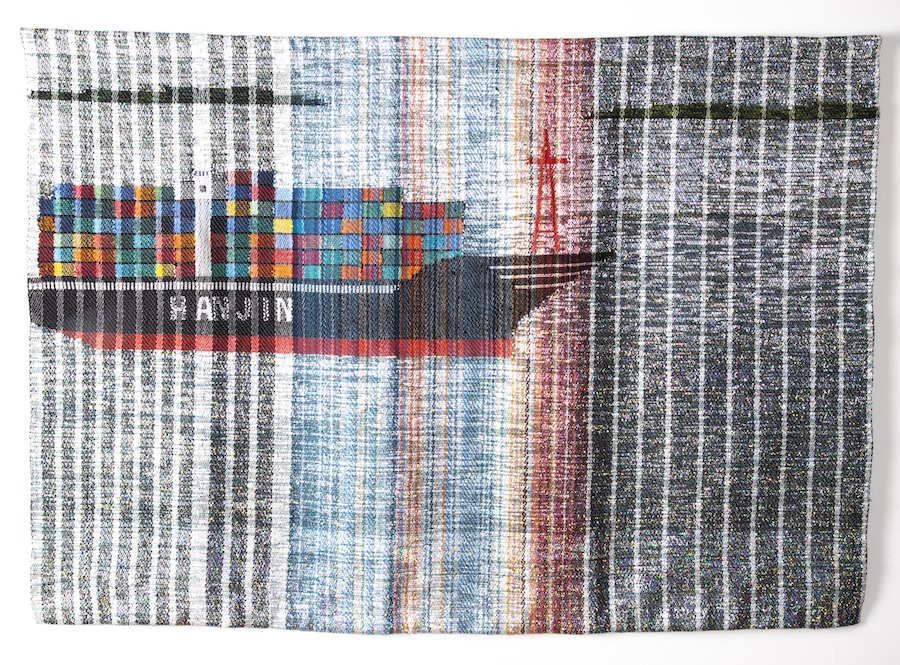Laura Foster Nicholson: Scenes From The Carbon Border
"Hanjin," 2021. 31” x 43 ½”. Wool, mylar, cotton. Nicholson used "warming stripes" to indicate long term warming trends.
From the hands of a young person in China, to a shipping container crossing the Suez Canal, to a semi-truck driver transporting containers cross country, to people at the big box or mom and pop who unload them, to everyone going to the stores to buy things. These are carbon borders we’ve created 一 our feet, our cars, trains, planes, streets, and sidewalks all in motion. These borders both connect and divide us.
Two years ago, driving from her home in New Harmony, Indiana to Chicago, artist Laura Foster Nicholson — a textile artist known for her handwoven tapestries — paused to notice the landscapes from our carbon borders. And the work she began creating then offers us — in this exhibition — a view of the path taken by the goods we purchase. This is often unseen and costs the world more than what’s listed on the price tag. And these carbon borders separate us from the people who made many of the items with which we live and adorn ourselves.
Nicholson noticed the cost to the environment and ultimately ourselves. She began incorporating these aspects in her works, calling attention to disasters and accidents along these borders, reminding us of the seen and unseen dangers of our way of life. “I watched the Wabash swell annually, frequently inundating the fields, sometimes filling basements, and once in a while warranting the efforts of the National Guard to sandbag around the New Harmony Inn. This past couple of weeks, texts have updated me regularly about extending the flash flood warning for the area,” says Nicholoson.
With this, we can pause to consider the invisible people and places behind items we consume and the inevitable disasters that result from the journeys. As each piece takes many hours to create, Nicholson’s work gives us access to our connectedness as humans instead of being based on consumerism and the whims of market research and algorithms. “As an artist, I am first visually inspired: the reflections in the water of these structures, foretelling the future, reflecting the past,” says Nicholoson.
This work reminds us that though we say the world has become smaller, we have become more distant from one another. No longer do we know all the hands that touched the objects we use to define ourselves. These tapestries are scenes from the carbon borders driven by our consumption and connecting us like the threads of her works.
Laura Foster Nicholson’s artwork is in several museum collections, including the Art Institute of Chicago, the Minneapolis Institute of Art, and the Denver Art Museum. With a BFA from Kansas City Art Institute and MFA from Cranbrook Academy of Art, she has lectured, taught, and exhibited in the US, Canada and Italy. She has been awarded an NEA fellowship, the Leone di Pietra prize at the Venice Biennale of Architecture, three Illinois Arts Council fellowships, and a grant from the Graham Foundation for Research in the Fine Arts. Most recently she was awarded the Dehaan Artist of Distinction grant.
Part of our Social Alchemy Project in partnership with University of Southern Indiana & The New Harmony Gallery of Contemporary Art- this exhibit was made possible by Indiana Humanities, Allen Whitehill Clowes Charitable Foundation, The Arts Council of Indianapolis, The City of Indianapolis, The Efroymson Family Fund and The Andy Warhol Foundation for the Visual Arts.

